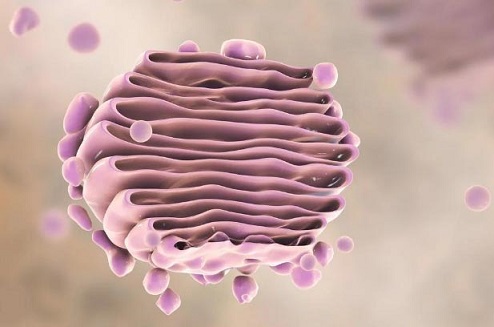Singapore scientists discover that SARS-CoV-2 spike protein undergoes transformation at Golgi complex
Nikhil Prasad Fact checked by:Thailand Medical News Team Jul 24, 2024 8 months, 3 weeks, 6 days, 10 hours, 42 minutes ago
COVID-19 News: A New Discovery
Researchers from Nanyang Technological University and the National Centre for Infectious Diseases in Singapore have made a significant discovery about the SARS-CoV-2 virus. This
COVID-19 News report delves into their groundbreaking study, shedding light on how the virus's spike protein changes shape within human cells to that interestingly enables better neutralization by antibodies. These findings have crucial implications for the development of vaccines and treatments for COVID-19.
 Singapore scientists discover that SARS-CoV-2 spike protein undergoes transformation at Golgi complex
Detailed Study Methodology
Singapore scientists discover that SARS-CoV-2 spike protein undergoes transformation at Golgi complex
Detailed Study Methodology
The study, led by Yanjun Wu, Soak Kuan Lai, Conrad En-Zuo Chan, Boon Huan Tan, and Richard J Sugrue, focused on the SARS-CoV-2 spike (S) protein. This protein is essential for the virus's ability to infect human cells, as it facilitates the virus's entry by binding to the ACE2 receptor on host cells.
The team expressed recombinant SARS-CoV-2 S protein in Vero cells and used a panel of human monoclonal antibodies (PD4, PD5, sc23, and sc29) to examine the protein. These antibodies recognized different parts of the S protein, allowing the researchers to map out where and how the protein changes shape. The researchers used a combination of imaging techniques to study the S protein in Vero cells, a type of cell commonly used in virology research.
Key Findings
The study findings revealed that specific changes occur in the S protein at the Golgi complex, a crucial cell organelle involved in protein modification and transport.
The study data indicated that the antibody binding epitopes recognized by the human monoclonal antibodies formed at different locations in the secretory pathway during S protein transport. However, a conformational change in the S1 subunit at the Golgi complex formed antibody binding epitopes recognized by virus-neutralizing antibodies.
The Role of the Golgi Complex
The Golgi complex is responsible for processing and packaging proteins before they are sent to their final destinations within or outside the cell. The study showed that as the S protein moves through the Golgi complex, it undergoes conformational changes that expose new antibody binding sites. These changes were specifically observed in the S1 subunit of the S protein, which contains the receptor-binding domain (RBD).
Antibodies PD4 and sc23 recognized conformationally specific epitopes in the S2 protein subunit at the endoplasmic reticulum and Golgi complex. Meanwhile, PD5 detected a conformational structure within the S1 subunit at the Golgi complex. This suggests that the Golgi complex plays a crucial role in preparing the S protein for recognition by neutralizing antibodies.
This finding is particularly significant because it highlights a potential target for therapeutic antibodies designed to block the virus's entry into human cells.
On the other hand, PD4 and sc29 recognized epitopes in the S2 subunit. These antibodies exhibited a more diffuse staining pattern, suggesting that their binding sites were more widely distributed within the cell.
Golgi Complex: The Site of Crucial Changes
The study provided compelling evidence that the Golgi complex is the site where crucial conformational changes occur in the S protein. These changes enable the protein to present new epitopes that can be targeted by neutralizing antibodies. This discovery underscores the importance of the Golgi complex in the virus's life cycle and its potential as a target for antiviral strategies.
Implications for Vaccine and Therapeutic Development
Understanding how the S protein changes shape in the Golgi complex is vital for developing effective vaccines and treatments. By targeting the specific conformations of the S protein that emerge in the Golgi, researchers can design more effective therapeutic antibodies and improve vaccine efficacy.
Future Research Directions
The findings from this study open up several avenues for future research. Understanding the precise mechanisms behind the conformational changes in the S protein could lead to the development of more effective vaccines and therapies. Additionally, exploring how different variants of SARS-CoV-2 affect these conformational changes could provide insights into the virus's evolution and help predict the emergence of new variants.
Conclusion
The study by Singapore researchers at Nanyang Technological University and the National Centre for Infectious Diseases provides valuable insights into the behavior of the SARS-CoV-2 spike protein within human cells. By identifying the Golgi complex as a critical site for conformational changes, this research paves the way for the development of more targeted and effective treatments for COVID-19. The findings underscore the importance of continued research into the molecular mechanisms of the virus to combat the ongoing pandemic.
The study findings were published in the peer-reviewed journal: Virology.
https://www.sciencedirect.com/science/article/abs/pii/S0042682224002083
For the latest
COVID-19 News, keep on logging to Thailand Medical News.
Read Also:
https://www.thailandmedical.news/news/sars-cov-2-virus-triggers-airway-inflammation-by-blocking-cftr-protein
https://www.thailandmedical.news/news/inhibiting-mrna-nuclear-export-increases-sars-cov-2-pathogenic-potential
https://www.thailandmedical.news/news/study-finds-that-cd74-and-d-dopachrome-tautomerase-plays-a-role-in-covid-19
